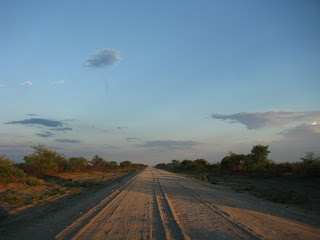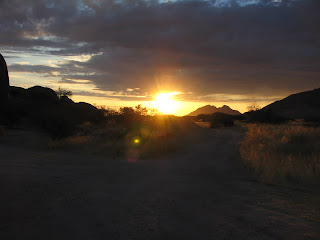
Today was about establishing a comfortable and honest rapport, and making it very clear that we are simply there to spend time with the San on their terms. We are not staging events, or worse, re-creating sound bites for a tourism advert.
I decided to bring only half the crew – no need to overwhelm the San with several new faces and extra camera gear.
*****
‘There,’ says Leon from the passenger seat, his voice barely above a whisper.
After a 40-minute drive on the single dirt road, we have found our village. The round huts, 12 in all, are all roughly the same size – the diameter of an inflatable children’s wading pool. We stop the cars, peer towards the ‘village of small huts,’ and prepare our gift.
According to the Nye Nye Conservancy (the local organization whose mission it is to preserve and protect the San way of life), it is customary to bring an offering of tea, maize, tobacco, etc, all in a large Rubbermaid tub. We are careful not to bring too much, which could disturb the balance of social and economic order.
(There is a history of white / western man believing that he is doing good when he brings a boatload of cash and gifts into tribal areas. What this white man doesn’t realize is that after he leaves, the tribes often fight over such gifts… and their own system of currency frequently collapses).
As we enter the village several faces emerge from behind trees and huts – the faces of small children. They are cautious, and curious, but not afraid. It seems they are eager to come greet us, but they must wait for something first. Permission? A signal?
Both, it turns out. Leon introduces us to a small cluster of older men and women sitting in a circle – difficult to determine their age – and right away the San kids make their way toward us.
I want to focus my attention on the conversation with the elders, as Leon translates, but I can’t help but turn to the kids. I smile and offer a small wave, which they return; yet still they are cautious in their approach.
Through Leon, the elders assure us we are welcome to stay. Truth be told, it is not the first time they have been visited by a small film crew; and on the whole this is a good thing. It means they are open to the experience, and willing to share their lives.
To hear San language for the first time is a truly unique experience. It consists of regular vowel sounds, punctuated by a distinct clicking and popping. It is rhythmic, percussive and hypnotic.
To put things in perspective: modern English has a total of 34 vowel sounds. That’s it. 34. The San, on the other hand, have a whopping 131 different sounds they make in their dialect. So I ask you – which is the more developed language? The more evolved?
In his incredible and alarming book ‘The Wayfinders’ Wade Davis explains that, today, there are currently 7,000 languages being spoken on the planet. However. Entirely 50% of those languages will disappear in our lifetime. Consider the implications of this. Language is just the canary in the coalmine, for when a language is wiped out, with it goes tradition, myth, learning, art, science, stories, skills, spiritual connections…
It’s a sobering and terrifying thought, and a large part of why, I think, we are doing this series. What goes when language goes? Pretty much everything. Think of it – half the languages in the world, gone, before we die. As a word guy myself … I’m concerned. I’m worried.
ANYhoo… On THAT happy note… Check out THE WAYFINDERS by Wade Davis – it’s the 2009 Massey Lectures book (part of the series that includes Margaret Atwood’s PAYBACK from 2008). Davis in fact isolates the San as a perfect example of a culture and language that date back over 10,000 years. A culture that for the most part has not changed.
Until recently. But thanks to the Nye Nye Conservancy, and organizations like it, the San have a chance. They are able to sustain a decent living by selling their beautiful hand-made jewelry and artifacts through the Conservancy. And, yes, from visitors like us. We are paying them for the privilege of entering their village – as we would pay for any permit to film anywhere else in the world.
…but as I sit with the San elders around the circle, enchanted by their language and humbled by their generosity, I can’t help but feel the need to do more. To help. It’s a natural response, I suppose, my middle-class gut reaction to poverty. There’s a real danger here in romanticizing the ‘other,’ with the arrogant belief that as a white man of privilege I can do anything to improve their lives.
Luckily, as I will soon discover, there are things I can do.
But for now, on my first day in the village, it is best to simply listen, and learn. Check my assumptions at the door. And turn off whatever tap that leads me to believe I can fix this, I can solve this.
Maybe there is nothing to be fixed, or solved.
*****
The rest of the day was spent getting to know the San, as a people and as individuals.
By noon the sun was high and hot, and so we retired to one of the 12 huts. The women started to make intricate beaded jewelry from crushed ostrich eggs, and the men made tentative plans for the next couple of days -- collecting honey, hunting for small game, a dance ritual… and music. Always music.





























































